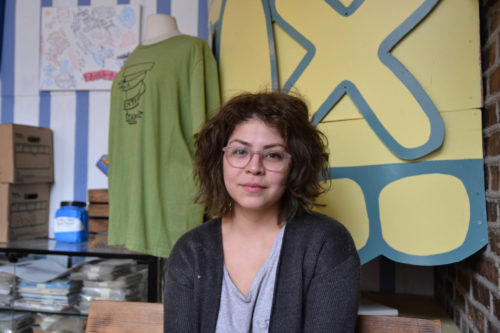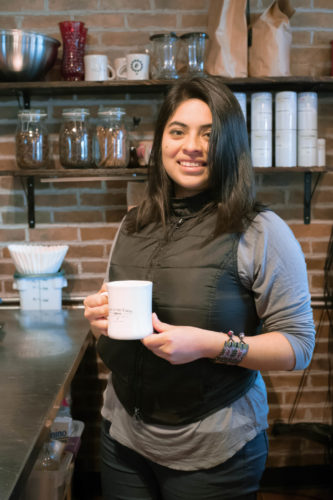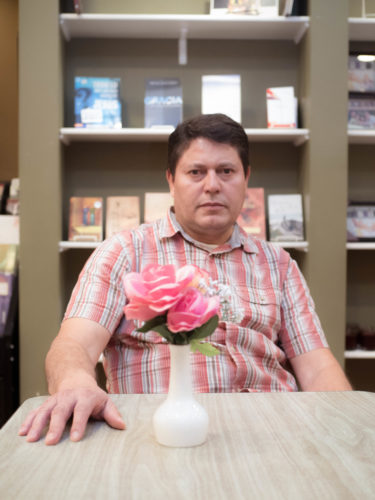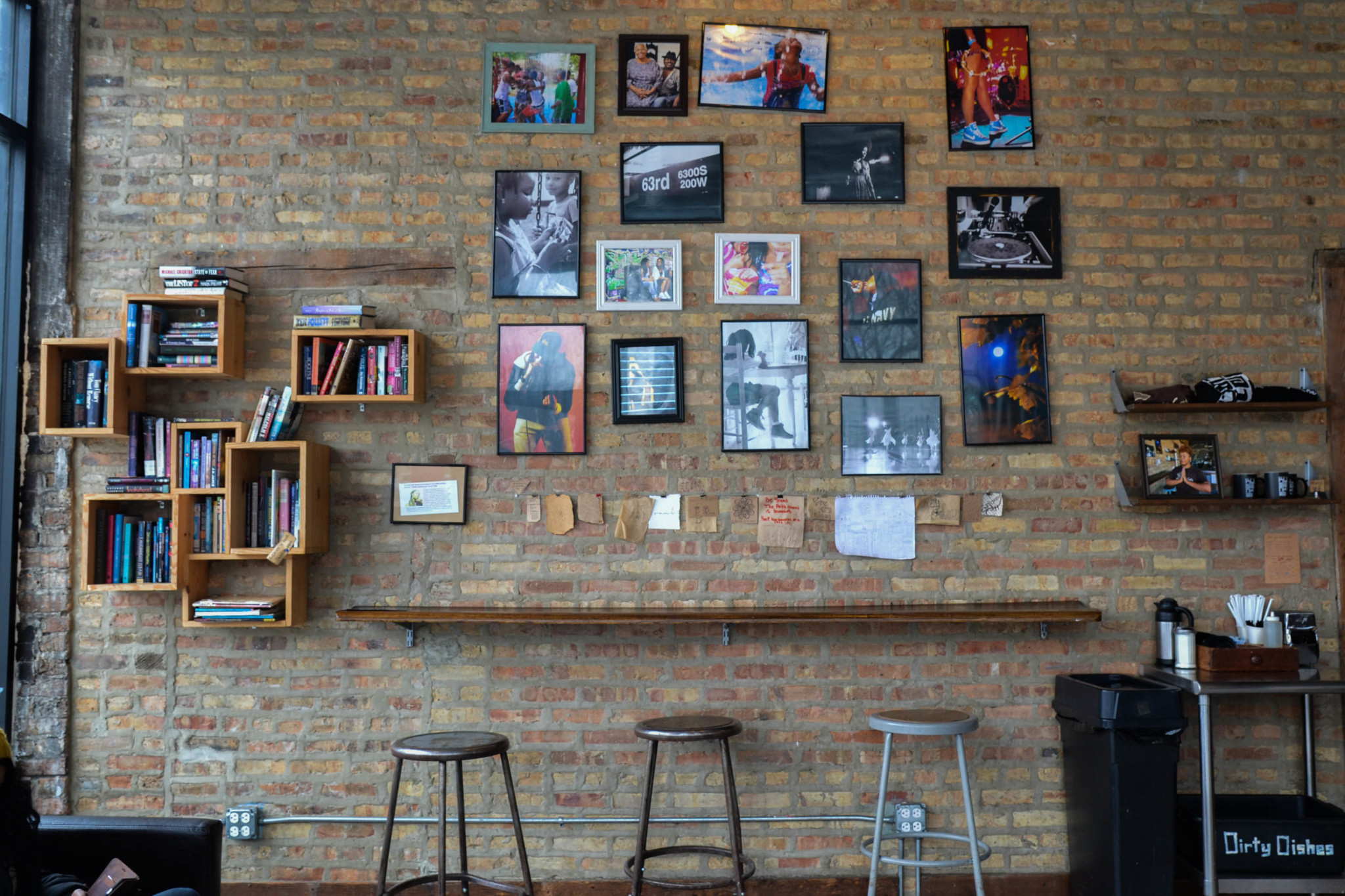It’s a quiet afternoon at Kusanya Cafe on 69th and Halsted, with a few people chatting over hot mugs of coffee or working on their laptops. The exposed brick walls give the space a stripped-down feel, but with colorful paintings and large windows that let in lots of natural light, the room feels warm and homey. Though the atmosphere and decor are mildly reminiscent of a café one might see in Uptown or Lincoln Park that serves infused lattes for five dollars, a quick glance at the menu hints that Kusanya isn’t a North Side transplant. A grilled mozzarella sandwich named Mozz Def and a ham panini named Ham Master Jay—plays on the names of rappers Mos Def and Jam Master Jay—indicate that Kusanya’s roots are firmly planted here in Englewood.
Customers at Kusanya get a laugh out of the sandwich and drink names, according to Phil Sipka, the café’s executive director. A cup of coffee sells for ninety cents, and almost everything on the menu is under five dollars, a far cry from five-dollar West Loop lattes. “Our mission is to be an intergenerational, inter-economic gathering place,” said Sipka. “If we’re not catching all economic segments, we’re not fulfilling our mission, so we try to price things so that everyone can come in and get something.”
Places like Kusanya Cafe, which opened in 2013, are part of a new wave of independent coffee shops that have opened on the South and West Sides, many just in the last few months. La Catrina in Pilsen, Back of the Yards Coffeehouse, Sanctuary Café in Hyde Park, Café El Meson in Brighton Park, Blood Fruit Library & Coffee in Bridgeport, Hope Cafe in Tri-Taylor, to name a few—they all have an explicit community orientation to them, some even an activist ethos. Others make a point of hiring formerly incarcerated people or youth. More like them are coming: South Shore Brew, slated to open later this year, plans to work with high school students. Even coffee shops without such formal programs have a keen sense of the role they seek to play in their neighborhoods, actively working to provide informal spaces where residents can convene, grassroots organizations can strategize, and artists can perform at open mics.
But if these shops’ owners strive to serve their communities, why open a café rather than a restaurant or community center? Interviews with a few of them indicate that the malleable nature of a coffee shop lends itself well to a purpose beyond coffee and pastries, a task difficult to emulate for a restaurant, where the conventions of what a customer expects are more rigid.
Hannah Nyhart, cofounder of Build Coffee next door to the Weekly’s own offices in Woodlawn (and a former Weekly editor), explained that coffee shops embody the idea of a “third place.” Not quite home but not quite work, “There aren’t as many bounds placed on you, and you can go alone or you can socialize or you can work, and all those things are equally acceptable,” she said.
But while coffee shops have the potential to foster community, that community doesn’t always include their neighbors. Coffee shops have become a kind of shorthand for gentrification; when a coffee shop moves in, it’s often understood as a sign that the neighborhood is changing—that new people are moving in, while people who have lived there for decades are being pushed out. A notable example of this dynamic is Bow Truss Coffee: when the North Side-based chain opened a now-closed location in Pilsen in 2014, it was met with anger and frustration from some members of the predominantly Mexican-American community.
What does it take for a coffee shop to serve the neighborhood that exists now, and not one that is expected to exist in ten years? It can donate unsold pastries or hold community programs from time to time, but that isn’t necessarily sufficient. Nyhart reflected this sentiment, saying, “A lot of people talk about the potential for coffee shops to be community spaces, and I think that is so true, but I don’t think that happens by itself; it takes very real work.”
Over the course of a few weeks, the Weekly sat down with the founders of a few notable South Side coffee shops that seem to have figured out their own ways to be a part of—rather than simply located—in their communities. How are they able to bring people together for a common purpose through coffee, without being one size fits all? And how do they consider the intricacies of their neighborhoods?
Kusanya Cafe
“I really want it to be like Englewood’s living room: we’ve had everything from baby showers to bakes and family stuff. The cafés that are successful…the neighborhood will make its mark on that coffee shop.” — Phil Sipka
In 2009, some residents who were active in planning a future for Englewood found themselves at a loss: there was no place in their neighborhood where they could sit down to meet and talk about their ideas. “We would literally have to go to another neighborhood to meet and talk about our own,” said Sipka.
The inspiration for Kusanya was born from this need for a space that was quiet yet informal, a space where both chance meetings and collaborative ones could happen. Coffee was the medium to facilitate this vision. “Coffee is something that I love personally, but is just a means to an end,” Sipka said. “I don’t know why in our culture we don’t go out for a glass of milk or OJ together, but we offer coffee or beer.”
But back in 2009, when Sipka and his neighbors were first having these discussions, the idea for gourmet coffee “was not even close” in terms of top priorities for the neighborhood. “It depends on who you talked to; either people loved the idea or they thought the neighborhood was too far away from [opening a café],” he said.
So they needed to be more intentional in how they presented themselves to the residents of Englewood.“It’s not hard to get the word out, but hard to get people in,” said Sipka. No amount of neighborhood programming, donations, or family initiatives can replace what is a genuine relationship with the residents of the community served. “You have to be established in a community first before you open up a café,” said Sipka. For Kusanya, that happened through attending numerous community planning meetings years before they opened, and having a board consisting of Englewood residents, including members of R.A.G.E., the Resident Association of Greater Englewood.
Kusanya is a nonprofit, though it would have made little difference to be a for-profit, given the slim-to-nonexistent margins Kusanya operates on. It is also much more difficult to do taxes as a nonprofit, a point made by all the café owners I spoke to. But Sipka and the other Englewood residents who worked to open the café chose to make it a nonprofit to make it clear that no one has a financial stake in the café, and that the café is meant to benefit the community.
Sipka decided to keep the uses for the space open-ended, letting Englewood residents decide what programs or events they want to hold. He thinks it’s one of the best decisions he made: “We all have the God complex of this is what we wanna see in our community, what the community should or shouldn’t have, and then we try to save it with a program like most nonprofits do. We waited until community residents stepped forward and said, ‘Hey, I really wanna do this.’”
Since then, Kusanya has hosted multiple events a month. Artists like Erik Jones have started programs such as Sound Voyage, a free lunchtime music series that showcases R&B, jazz, Afro-Latin, and reggae artists. Kusanya also opens up its Roasting Room for a yoga class every Saturday. In a Weekly article published a year ago, Jones said he chose Kusanya because it was an outlier in the neighborhood, bringing about “a change in people having the ability to come just as they are, sit, talk, do their work, have a wi-fi connection.”
La Catrina
“Yeah, I can see how some people think that cafés mean gentrification, but at the end of the day, you have to see what these businesses are giving back.” — Paola Zamora

La Catrina has become a neighborhood staple since husband and wife co-owner duo and longtime Pilsen residents Diana Galicia and Salvador “Sal” Corona opened it five years ago. Unlike Kusanya, La Catrina is a family-owned shop, and it draws its activist mission from a different place.
After the unexpected death of Gabriel Cisneros, an artist and the son of Galicia and Corona, they decided to start The Gabriel Project, an organization that works to bring young people away from violence and drugs through art, mentorship, and a space for personal expression.
Anyone who walks by the café on 18th Street will notice the expanse of Mayan-inspired murals by Pilsen artist Salvador Vega that cover its brick walls. “Art is in everything we do,” said Paola Zamora, who co-manages the café. “La Catrina is just filled with Mexican culture, and Mexican culture is very vibrant, colorful, and it’s very much just artistic.”
I spoke to Zamora, who is also heavily involved with The Gabriel Project, in a side room at La Catrina dedicated to Gabriel that has walls painted by his friends and family and decorated with his art and favorite t-shirts.
The Gabriel Project’s first project was the restoration of a mural in Little Village originally painted by Vicente Mendoza in the 1980s. For six weeks over the summer, young artists worked with painters including Corona and Robert Valdez at the corner of 26th and Pulaski from seven in the morning till sundown. Other projects are more workshop-based, such as a youth sexual consent class and a training on how to save the life of someone who has overdosed. “We’re currently trying to start more projects, just to keep the kids off the street, to teach them things that they need to know,” Zamora said.
La Catrina does not have one particular activist mission as a café, but works more broadly to promotes safe spaces where new, Latinx voices can be heard. “What I want people to get from La Catrina is to know that this is a space for them and this is a space specifically for POC to organize, and to feel safe, and to have a voice,” said Zamora. In addition to hosting events for The Gabriel Project, La Catrina regularly opens up its space for a variety of organizations such as ChiResists, Chicago United for Equity, and Pilsen Alliance, which has held several meetings on gentrification, all for free. It also plays host to programming from arts nonprofit Cultura.
When I asked Zamora, who grew up in Pilsen, what the neighborhood means to her, she said that Pilsen is home and that she wouldn’t want to build a life anywhere else. But changes to the Pilsen she knew growing up in are becoming more and more apparent each day. When the murals outside of Casa Atzlan community center were painted over this summer, the change shook the community. “The mural still being there gave us hope that Casa Azlan was still ours, our Pilsen…and then they took that, by painting over it.”
Zamora said the development and gentrification are only going to “be faster and [more] in-your-face” in coming years, which is why “La Catrina has to stay, and has to be a staple in this neighborhood.”
Back of the Yards Coffeehouse and Roaster
“The neighborhood’s always had a bad rep, so working at the café makes me feel like I’m doing something good in the community, and I’m educating people about high quality coffee too.” — Eduardo Rodriguez

Chicago native Jesse Iñiguez was stunned when he walked into a coffee shop for the first time soon after starting college. In his eighteen years of life, he had never seen anything like that—a place to meet up and discuss ideas—in his neighborhood, Back of the Yards. Eighteen years later, Iñiguez and his business partner, Mayra Hernandez, opened up their own coffee shop and roastery, Back of the Yards Coffeehouse and Roaster, on the corner of 47th and Hoyne.
Once Hernandez had poured me a glass of the shop’s signature Horchata Latte cold brew, I sat down with Iñiguez on the patio to talk about his connection to Back of the Yards, his vision for the coffeehouse’s role in the neighborhood, and the coffee itself.
Back of the Yards Coffeehouse and Roaster’s opening last January is the result of years of planning, fundraising, saving, and risk-taking. Indeed, Iñiguez and Hernandez put their entire life savings into the shop, and they did that because the coffeehouse is not just a business for them—it’s personal.
Iñiguez, who said he has been an activist and leader in his community since he was a teenager, tells me that there was only one place to get a coffee in Back of the Yards: the Starbucks on 47th Street. What they wanted to do was create something totally different;a place where anybody from their community could meet up, have a coffee that’s good enough to stand on its own, and, most importantly, support their neighborhood.
The coffeehouse, and the roastery next door, are social-impact driven. First of all, Iñiguez and Hernandez will invest some of the shop’s profits back into funds that will benefit the community: for every twelve-dollar bag of coffee purchased, one dollar goes into a community impact fund for initiatives like Kids Café at Casa Romero, a program that provides afterschool and summer meals for low-income students.
In addition to these impact investments, the coffeehouse provides a much-needed meeting space for the Back of the Yards community. Activists and community leaders are already frequenting the café, which has plenty of space for meetings and events. Moreover, Iñiguez and Hernandez have already hosted a few events in an effort to bring their community together, including an open mic series called Microfoam. “It’s just a really nice place a lot of people can come to hang out at, and also a really comfortable place to do homework or work,” said barista Eduardo Rodriguez.
The shop has a unique relationship with the high school across the street, Back of the Yards College Preparatory: in an effort to keep the school’s students off the street, Iñiguez and Hernandez have hired a student and made it clear students are always welcome in the shop, even if they do not buy anything.
Café El Meson
“We are not here just to make money, we’re here to be a blessing for the community, especially young people. For students in middle school to college students with their laptops, if they come here to study, they’re role models for others to follow.” — Juan Crespo

It’s a rainy Monday afternoon in Brighton Park, a predominantly Latinx and working-class neighborhood. A few steps off a busy intersection at Kedzie and 47th is Café El Meson, where I go to find a quiet spot to warm up and relax.
Inside, Juan Crespo, the founder and owner of the café, is speaking with one of his customers, who just brought back a bag of pastries and candies for him from a trip to Mexico. “We don’t have a lot of traffic, but with the traffic that we do have, we’ve been able to create a good community, good friendships,” Crespo said.
Café El Meson is a nonprofit bookstore and café, and a beloved neighborhood institution whose mission is to provide a space for gathering, encouragement, and even advice. The main business of El Meson is the café on the first floor, where Crespo and his employees craft paninis and drinks such as the popular Coco Latte or the Pina Colada smoothie. Lining the walls are bookshelves stocked with various Christian books, biographies, and self-help books.
Crespo said that he is intentional about what books he sells because his vision for the café is tied with his personal faith, but he aims to make it clear that the café is welcoming to people of all faiths and follows rules to make sure everyone feels comfortable.
Before opening El Meson, Crespo had owned a car business in the lot next door and was fairly financially successful. But one day he realized he was not doing anything for the community he was making money from, and spending what he made elsewhere. He wanted to give back.
“I picked Brighton Park because I had the car business here, not thinking about whether or not the location would be profitable. The coffee shop is about location, and the ten years that we’ve been here have been very hard, financially,” Crespo said.
Despite the financial hardships, Crespo is glad to have El Meson. He said that with a coffee shop, he has been able to create a community in a way that the numerous pizzerias or taquerias in Brighton Park haven’t been able to do. “Coffee shops are about relationships, but restaurants are about eating and leaving,” he said. In fact, Crespo knows almost everyone who’s walked into the shop, and he easily strikes up conversations with those he doesn’t.
Looking back, El Meson was the last café I visited for a good reason. Having been around for the longest, El Meson was one vision for what a café that is truly invested and integrated within a community can look like. It exists to serve the needs of residents of Brighton Park, whether that’s by offering students a quiet space to study for on the second floor, providing free late-night printing services when the library is closed, or offering open mic nights. When residents wanted to make an impact outside of their community, El Meson decided to support an international aid nonprofit by donating used books and soccer balls to villages in Honduras.
Residents are committed to El Meson, too. Crespo told me about a customer who was an electrician who offered to fix and replace the kitchen oven for free. Another customer even comes in on Saturday nights to help clean the café.
“Last summer, this community had a lot of crime, as you probably saw in the news, but there’re so many good things going on in the community that you only know if you’re around,” said Crespo. For me to have a café in the community and be here every day, that gave me the opportunity to get to know other people.”
Support community journalism by donating to South Side Weekly

